In Conversation With… Keith Lilley, Living Legacies
Posted on April 29, 2016 by Hannah Clark – Imperial War Museums
Please introduce yourself.
I’m Keith Lilley, Professor of Historical Geography at Queen’s University Belfast and Director of “Living Legacies 1914-18: From Past Conflict to Shared Future”, which, led by Queen’s University Belfast in collaboration with National Museums Northern Ireland, is one of five ‘World War One Engagement Centres’ in the UK funded by the Arts and Humanities Research Council, created through a partnership with the Heritage Lottery Fund (HLF).
What are your plans for 2016?
The engagement centres’ role is to support a wide range of community engagement activities across the UK, connecting academic and public histories of WW1 as part of the commemoration of the War’s centenary.
Why is it important for your organisation to reflect on the Centenary of 1916?
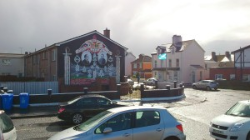
Face to face with the Battle of the Somme, mural, east Belfast: photo K Lilley, 26 March 2015.
Visitors arriving in Northern Ireland, at George Best Belfast City Airport, come face to face with the landscape of the Somme. On an end gable of a house, facing onto the airport and approach road, is a mural, commemorating and memorialising the ‘blood sacrifice’ of local men in July 1916. This mural is one of many such localised images and memorials to the Battle of the Somme, linking communities across Northern Ireland with a place and a time seemingly far removed from 2016, yet actually deeply embedded and rooted in local identities and imagination.
The Battle of the Somme, The Easter Rising, each momentous events of 1916 in their own right, yet not simply remembered and recalled through the centenary commemorations in this centenary year but, in Northern Ireland, actually live on in the twenty-first century.
This continued resonance of the Great War in contemporary society, culture and politics on the island and Ireland, demonstrates that the experience of commemorating WW1 is differentiated geographically, for the past connects with the present through place. Understanding these varied and uneven localised geographies of community and communal remembrance of WW1 makes for a more interesting and richer story, and clearly a more meaningful one for those engaged in these Centenary projects. Of course all our various collective and individual acts of remembrance take place in place, but what is important is thinking this through in terms of how places shape these and in the process forge connections between communities past and present.
For Living Legacies this idea, that the very acts of commemoration are rooted, situated, localised is important, for our centenary projects all take place in place.
Led by Queen’s University Belfast, in collaboration with National Museums Northern Ireland,“Living Legacies 1914-18: From Past Conflict to Shared Future” is one of five ‘World War One Engagement Centres’ in the UK funded by the Arts and Humanities Research Council, created through a partnership with the Heritage Lottery Fund (HLF). The engagement centres’ role is to support a wide range of community engagement activities across the UK, connecting academic and public histories of WW1 as part of the commemoration of the War’s centenary.
To this end, as a collaboration between community and academic researchers interested in how the World War 1 lives on in the twenty-first century world, Living Legacies was established in 2014 to help community-led WW1 centenary research projects to achieve greater levels of impact, outreach and engagement beyond their immediate localities. What is interesting is how, through the localised nature of many funded community projects, the Centenary of WWI is itself making histories and shaping our relationships to the present through the past. And what is important in all this is capturing these localised and grounded stories about the war, and its contemporary legacies and resonances, recognising their differences as well as certain commonalities.
2016 marks the halfway point in the Centenary of WW1, as well of course as a significant centenary year in itself, especially here on the island of Ireland where the Living Legacies engagement centre is based.
The Easter Rising and the Somme loom large on the Centenary’s landscape, and rightly so.
But while the Centre is equally as interested in the major events of the war’s centenary it is equally concerned with connecting with the local impacts of the war, and the Centenary community projects that are exploring this. So over the past two years Living Legacies’ university and museums researchers have partnered with community-based networks and projects to capture, study and interpret the enduring legacies of WW1. This has led to a range of community engagement initiatives that are uniquely tuned to the localities of Northern Ireland and their political and cultural diversity.
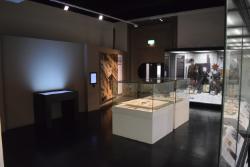
“Remembering 1916: Your Stories” Gallery, Ulster Museum, Belfast
The “Remembering 1916: Your Voices” exhibition co-curated by Living Legacies and National Museums Northern Ireland is one example of this, drawing on community objects and stories and linking them with museums’ collections to weave new narratives around 1916 and the centenary, narratives that link across communities and across time, connecting past with present. Likewise ‘Living Legacies’ public outreach activities in 2014 and 2015 yielded community stories and objects that now feature in the BBC NI Voices ’16 multimedia platform.
Through their geographies as much as their histories, then, the many community-based WW1 Centenary projects that have emerged since 2014 across the “home nations” go way beyond the local. Yet, and despite this being an age of the ‘global village’, of social media and digital connectivity, individual relationships with commemorating and memorialising the global war are forged locally, localised through community projects. Looking at these public engagements with the past, with the Somme, with the Easter Rising, in place, in fact heightens and reinforces a sense of localised cultural identities, reflecting our current fractured, post-devolution political landscape of these islands, of ‘nations within the nation’.
The commemorative experience is all the richer for this, and the living legacies of 1914-18 are just as interesting, and certainly as important, as the impact of the War itself on societies across the islands a hundred years ago.
Prof. Keith Lilley
Director ‘Living Legacies 1914-18: From Past Conflict to Shared Future’ WW1 public engagement centre


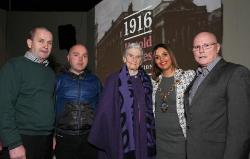 Creative Cetenaries - Untold Stories Exhibition
Creative Cetenaries - Untold Stories Exhibition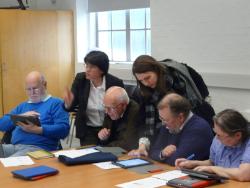 On Tuesday 12th April 2016 Dr Marie Coleman (Queen’s University, Belfast) led a free workshop at the Ulster Museum, Belfast. The workshop examined the key sources available for those looking to find out more about their ancestors’ service in the First World War, including the Easter Rising and the subsequent revolutionary years in Ireland up to 1923. Those attending were informed about what can be gleaned from First World War physical memorials and the printed Ireland’s Memorial Records, which are now available online (
On Tuesday 12th April 2016 Dr Marie Coleman (Queen’s University, Belfast) led a free workshop at the Ulster Museum, Belfast. The workshop examined the key sources available for those looking to find out more about their ancestors’ service in the First World War, including the Easter Rising and the subsequent revolutionary years in Ireland up to 1923. Those attending were informed about what can be gleaned from First World War physical memorials and the printed Ireland’s Memorial Records, which are now available online (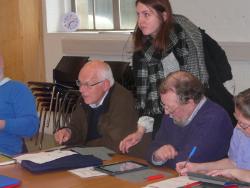 A total of 10 individuals booked places at the workshop. Feedback on the evaluation forms included the following: “Very informative and easy to understand”, “Very good tutor”, “I learnt how much information is now available on the Internet and a lot of it free”, and “I go away with a better selection of websites to look up”. A partnership with the Nerve Centre meant that iPads were available for those attending to look up a selection of the websites referred to during the workshop, and at least two of those attending were able to find out something about an ancestor that they did not previously know!
A total of 10 individuals booked places at the workshop. Feedback on the evaluation forms included the following: “Very informative and easy to understand”, “Very good tutor”, “I learnt how much information is now available on the Internet and a lot of it free”, and “I go away with a better selection of websites to look up”. A partnership with the Nerve Centre meant that iPads were available for those attending to look up a selection of the websites referred to during the workshop, and at least two of those attending were able to find out something about an ancestor that they did not previously know!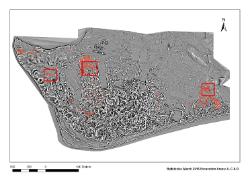
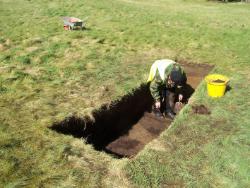 Work focused on three locations within the confines of the military estate and information uncovered will now be used to inform the project design for the planned August excavations and community outreach project. The archaeological investigations were carried out on behalf of the MoD by the Centre for Archaeological Fieldwork (CAF), School of Geography, Archaeology and Palaeoecology (GAP), Queen’s University Belfast under the co-direction of Heather Montgomery (QUB/PG) and Dr Paul Logue (Senior Inspector, HED). The project was financed by Defence Infrastructural Organisation (DIO) and Queen’s University Belfast’s First World War Living Legacy Engagement Centre.
Work focused on three locations within the confines of the military estate and information uncovered will now be used to inform the project design for the planned August excavations and community outreach project. The archaeological investigations were carried out on behalf of the MoD by the Centre for Archaeological Fieldwork (CAF), School of Geography, Archaeology and Palaeoecology (GAP), Queen’s University Belfast under the co-direction of Heather Montgomery (QUB/PG) and Dr Paul Logue (Senior Inspector, HED). The project was financed by Defence Infrastructural Organisation (DIO) and Queen’s University Belfast’s First World War Living Legacy Engagement Centre.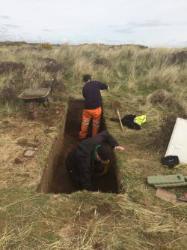 This program of work is the first excavation of this type in Northern Ireland to include the evaluation of a First World War facsimile trench system. It is anticipated that information gleaned through both the desktop analysis and the fieldwork will augment the current historical narrative of the site while informing the accurate interpretation of the physical remains of ‘training for war’, garnering a greater understanding of the British training doctrine provided to the volunteer recruits in Ireland who trained there prior to heading to the war in 1914-1918. In addition the works will afford commemorative outreach to both the local community, the MoD rehabilitation scheme (The Nightingale Project), and further build upon relationships with the Irish Defence Force (IDF).
This program of work is the first excavation of this type in Northern Ireland to include the evaluation of a First World War facsimile trench system. It is anticipated that information gleaned through both the desktop analysis and the fieldwork will augment the current historical narrative of the site while informing the accurate interpretation of the physical remains of ‘training for war’, garnering a greater understanding of the British training doctrine provided to the volunteer recruits in Ireland who trained there prior to heading to the war in 1914-1918. In addition the works will afford commemorative outreach to both the local community, the MoD rehabilitation scheme (The Nightingale Project), and further build upon relationships with the Irish Defence Force (IDF).